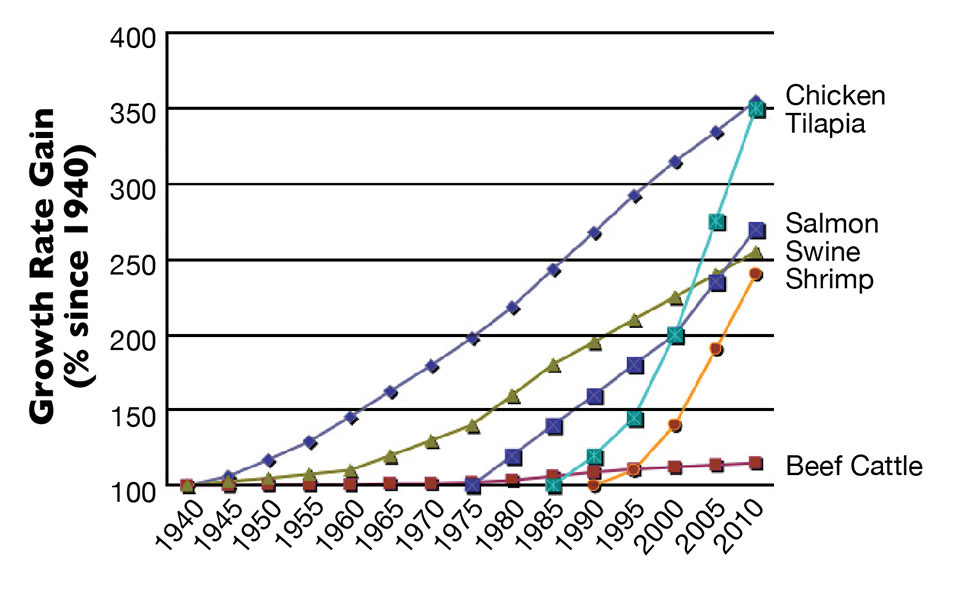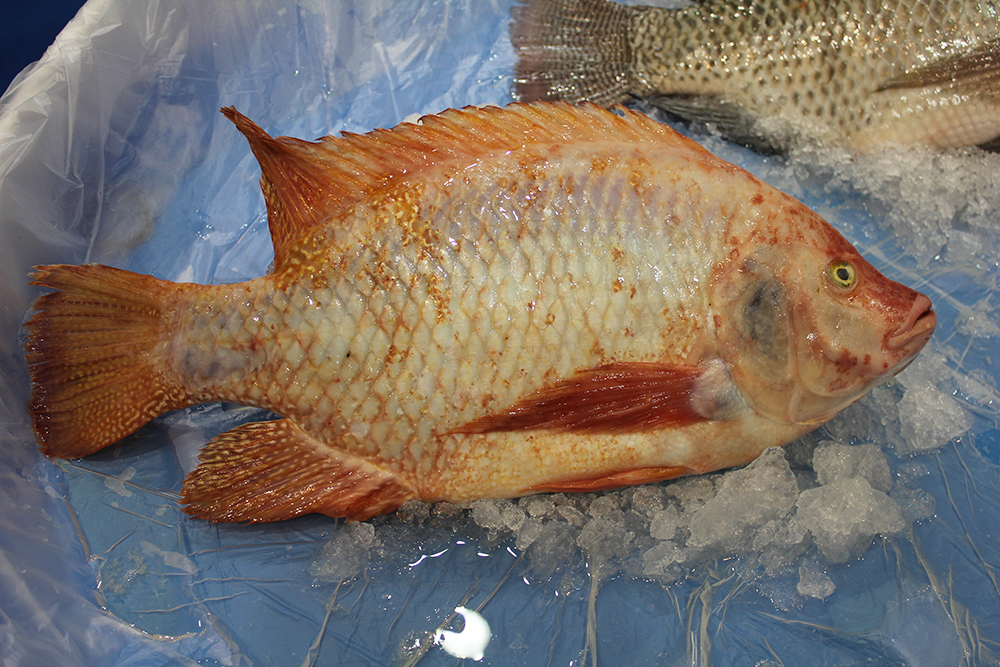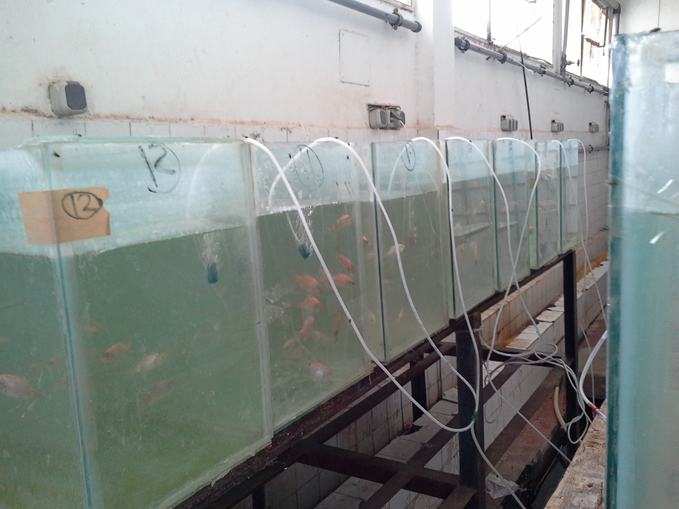Practice allows farms to be more competitive and better able to withstand economic downturns

Selective breeding of aquaculture animals has been practiced commercially only since about 1975 – not long when compared to the selective breeding work for terrestrial animals. It is estimated that less than 15 percent of all aquaculture animals in production today were derived from selective-breeding programs.
Poultry and swine production has increased greatly since organized breeding programs were instituted at universities and federal agricultural research institutes in the early 1900s. Poultry and swine growth rates have increased 350 and 250 percent, respectively, over their 1940 levels.
Rapid gains in aquaculture
The improvements in growth rates for tilapia, salmon and shrimp have been much more rapid than terrestrial animal selection advances. As shown in Fig. 1, growth rates for tilapia have risen 350 percent since 1985, while salmon rates rose 270 percent since 1975. Growth rates for shrimp increased 240 percent since 1990.

These numbers reflect degrees of improvement similar to those for major terrestrial species, but occurred over a much shorter time period. This is due to the much higher rate of proliferation for aquaculture animals. Most aquaculture animals are sexually mature at young ages and tend to have thousands to hundreds of thousands of offspring from each mating.
Genetics trails nutrition
It is important for hatchery and grow-out facility operators to understand that selective breeding as a practice is lagging behind nutrition research in aquaculture. This means that currently, environmental factors such as feed quality have a greater influence on growth rate and profitability than genetics.
However, the genetic potential of aquaculture animals is very plastic and can be improved over a short timeframe by utilizing a selective-breeding program. The potential benefits of selective breeding in aquaculture outweigh all other options for improving animal performance.
Genetic potential
With the exception of aquaculture, selective breeding has outpaced all other forms of agricultural research aimed at improving the growth rates of agriculture animals. The swine, poultry, dairy and beef industries all have animal populations with high growth rates that are more a function of genetics than of feeds, feeding methods and nutrition.
Aquaculture is just the opposite. There are reports of shrimp capable of growing up to 7 grams/week under ideal conditions, but this high rate of growth is often not obtained in a commercial farm setting. This is because an individual animal’s growth rate is a reflection of its parents’ growth rates.
Many more farms do not practice selective breeding than do. Yet only through selective breeding can the growth rates of the farm populations be increased. This is true across all aquaculture animals with the exception of a few salmonid species.
These species have been under selection for over 10 generations, and the growth rates for the animals have met market demands for the most part. However, there are no indications that the growth increases gained over the last 10 generations will taper off.
Limitations
Feed and nutrition research has outpaced genetic selection in aquaculture. Over 200 species of aquatic animals are reared, and many have complicated and undescribed reproductive cycles. However, the nutritional requirements across species are much more similar than the reproductive cycles, which allows widespread adoption of nutritionally advanced feed formulations.
Additionally, the large species diversity in aquaculture has played a role in limiting the ability to form and fund the level of organized selective breeding from which terrestrial animal agriculture has benefited. Many animals, especially marine finfish, are still derived from wild-caught broodstock. Complex and misunderstood breeding cycles hinder the science. The sheer number of species causes organized selection efforts to be diluted.
What benefits can be realized?
Aquaculture is still a young industry composed mainly of small independent farmers. The handful of very large industrial farms are far outnumbered by the small businesses.
Most small farm managers tend to believe starting a selective-breeding program costs too much and will take too many years to see any benefits. However, most terrestrial breeding programs report returns on investment between five- and 50-fold.
The economic benefits of selection in aquaculture animals are highly variable and depend on the market value of the species. It has also been established in aquaculture animals that growth rates can continuously increase an average of 10 percent/generation.
A brief economic analysis demonstrating the value of a selective-breeding program to a small tilapia farmer is provided in Table 1. The comparison is based on 10,000 fish/treatment (selected or non-selected) with the selected fish yielding 10 percent increased weight gain/day. Also, inherent benefits of selection include improved feed conversion and increased survival, which are improved by 2.6 and 3.2 percent, respectively, in this comparison.
Snyder, Economic analysis, Table 1
| Non-Selected | Selected | Difference | Difference | |
|---|---|---|---|---|
| Input Data | ||||
| No animals stocked | 10,000 | 10,000 | – | 0 |
| Weight gain/day (g) | 3.7 | 4.07 | – | 10.0% |
| Average weight at market (g) | 681 | 681 | 0.37 | 0 |
| Survival/yield (%) | 95 | 98 | – | 3.2% |
| Feed-conversion ratio | 1.11 | 1.08 | 0.03 | -2.6% |
| Fingerling cost (U.S. $) | 0.09 | 0.09 | (0.03) | 0 |
| Initial weight (g) | 15 | 15 | – | 0 |
| Market value (U.S. $/kg) | 5.50 | 5.50 | – | 0 |
| Feed cost (U.S. $/kg) | 0.994 | 0.994 | – | 0 |
| Overhead/day/fish (U.S. $) | 0.0022 | 0.0022 | – | 0 |
| Calculations | ||||
| Days in cycle | 180.00 | 163.64 | (16.36) | -9.1% |
| Total weight marketed (kg) | 6,469.50 | 6,673.80 | 204.30 | 3.2% |
| Value at market (U.S. $) | 35,582.25 | 36,705.90 | 1,123.65 | 3.2% |
| Cost of fingerlings (U.S. $) | 900.00 | 900.00 | – | 0 |
| Feed fed (kg) | 7,014.39 | 7,048.94 | 34.55 | 0.5% |
| Cost of feed fed (U.S. $) | 6,975.11 | 7,009.47 | 34.36 | 0.5% |
| Overhead cost (U.S. $) | 3,960.00 | 3,600.00 | (360.00) | -10.0% |
| Results | ||||
| Fingerling cost/kg marketed (U.S. $) | 0.139 | 0.135 | (0.004) | -3.1% |
| Feed cost/kg marketed (U.S. $) | 1.078 | 1.050 | (0.028) | -2.6% |
| Overhead cost/kg marketed (U.S. $) | 0.612 | 0.539 | (0.073) | -11.9% |
| Profit | ||||
| Income over fingerling, feed and overhead costs (U.S. $) | 23,747.14 | 25,196.43 | 1,449.29 | 6.1% |
| Other Factors/Adjustments | ||||
| Additional growth opportunity (U.S. $) | 732.60 | |||
| Advantage From Selection | 2,181.89 | 9.19% |
The potential economic benefits from these modest improvements in performance should help small farmers realize that the costs of incorporating selective breeding into farm management can be recovered in a relatively short period of time. In Table 1, the small changes in performance reduce the cycle period by 9.1 percent and increase both the market weight and total market value by 3.2 percent. They also increase the amount of feed and associated feed costs by 0.5 percent due to higher survival. The overall cost benefit is a 10 percent reduction in the overhead costs.
The results of a successful selective-breeding program can be two-fold. First, selective breeding resulting in increased survival and better feed conversion can help reduce costs. The example provided in Table 1 demonstrates a reduction in fingerling cost of 3.1 percent and a reduction in feed fed/kg marketed by 2.6 percent with a reduction in overhead costs/kg marketed of 11.9 percent.
Secondly, due to the improved survival and weight gain, profits calculated as income over feed, fingerlings and overhead costs improve by 6.1 percent. When the total benefit associated with reduced variable costs, increased profits and the opportunity associated with a shorter cycle are combined, the total benefit available per 10,000 tilapia raised is over $2,000.
Perspectives
Increasing production efficiency through selective breeding can result in substantial increases in farm profitability. Coupled with better feeds, feeding methods and nutrition, a progressive-minded aquaculturist can not only weather harsh economic conditions, but make improvements in the profitability of the business.
If you operate your own hatchery, there is great economic incentive to bring a science-based approach to selection. If you purchase larvae, fry or fingerlings for grow-out, there is economic benefit to purchasing from a supplier that practices selection. Learn to understand suppliers’ breeding programs and goals, and how they help you meet your growth needs.
Aquaculture operations improve profitability by making more opportunities to market their products. During poor economic times, controlling costs often takes precedence over management changes with associated costs. Management changes such as incorporating selective breeding allow a farm to be more competitive and better able to withstand economic downturns.
(Editor’s Note: This article was originally published in the January/February 2013 print edition of the Global Aquaculture Advocate.)
Authors
-
Scott Snyder, Ph.D.
Animal Nutritionist
Zeigler Bros., Inc.
P. O. Box 95
Gardners, Pennsylvania 17324 USA[109,111,99,46,100,101,101,102,114,101,108,103,105,101,122,64,114,101,100,121,110,115,46,116,116,111,99,115]
-

Thomas R. Zeigler, Ph.D.
Senior Technical Advisor
Past President and Chairman
Zeigler Bros., Inc.
P. O. Box 95
Gardners, Pennsylvania 17324 USA
Related Posts

Health & Welfare
A holistic management approach to EMS
Early Mortality Syndrome has devastated farmed shrimp in Asia and Latin America. With better understanding of the pathogen and the development and improvement of novel strategies, shrimp farmers are now able to better manage the disease.

Intelligence
Adding value to tilapia to tap into U.S. market
New markets for tilapia and expansion of existing ones can be created by planning and implementing properly designed geographic strategies to meet discriminating consumer preferences. Low labor costs in most producing countries promotes value-adding by the production of fresh fillets.

Responsibility
An African prison where fish will be farmed and lives saved
A nonprofit organization working to improve conditions in African prisons is hoping tilapia ponds, tended to by inmates, will aid in their nutrition. A small donation from the Global Aquaculture Alliance will go a long way.

Health & Welfare
Applied commercial breeding program for Nile tilapia in Egypt
A major goal of selective breeding program for Nile tilapia (Oreochromis niloticus) in Egypt is to select for fillet color and fillet weight in response to consumer preferences.


